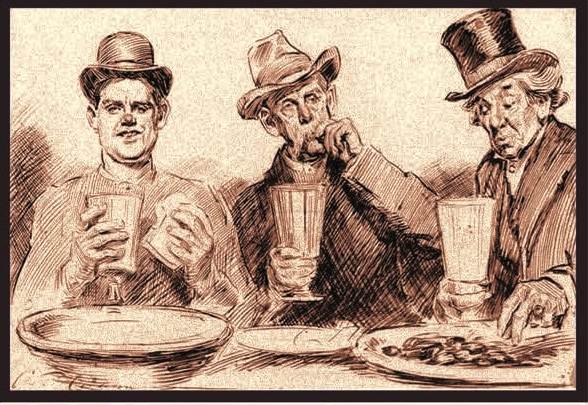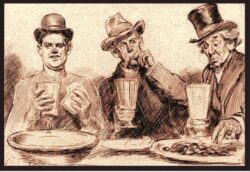Fall 2013
No Such Thing As a Free Lunch Anymore
Saloonkeepers’ choice: no money or customers?
Published: May 4, 2021
Last Updated: May 4, 2021

Illustrator Charles Dana Gibson captured these satisfied free lunch customers, circa 1910.
A few sources argue that offers of a free lunch originated in New Orleans’ bars, hotels and other public spaces in complement to the spectacle of auctions selling enslaved humans and other commodities. Lafcadio Hearn’s Historical Sketchbook and Guide to New Orleans (1885) credited a businessman named Alvarez, proprietor of the barroom of the St. Louis Hotel and City Exchange, for first serving free lunches in the 1830s. Hearn suggests that businessmen who lived too far from downtown to return home for lunch wanted to avoid paying restaurant prices, so Alvarez accommodated them. Auctions throughout the United States in the 1800s were often staged around the noon hour in coffeehouses and hotels, so in many cities food was served to draw customers. By the late 1800s free lunches were often provided during auctions or farm sales in rural areas, including many Louisiana towns.
In her research into saloon history, Madelon Powers, emeritus professor of history at the University of New Orleans, traced the tradition of providing free meals to the late Middle Ages, when English monastics believed it was “their Christian duty to provide hospitality to strangers on religious pilgrimages.” In 19th-century America, the liquor industry had transformed the concept for decidedly irreligious purposes.
Ads for free lunches first appear in New York City and Ohio newspapers in the 1850s. Beginning in 1860, New Orleans restaurant proprietor David Bidwell regularly advertised a free lunch each day of the week, from 10:30 am until 1 pm. The Phoenix, located in the St. Charles Hotel, may be the first documented free lunchroom in New Orleans.
One of the city’s newspapers in the late 1880s also credited New Orleans as “the birthplace of the free lunch. Here it sprang into life. Here it reached its highest perfection; here it survives to-day.” Before any commercial exchanges developed, businessmen were said to have negotiated on the levee, in the streets, and in barrooms.
According to the newspaper, bars “became commercial exchanges … and the free lunch was provided so that two merchants transacting business could do it over a plate of soup or a piece of roast beef. The free lunch became an institution here, and has remained ever since; and today it is far more general and usually of a far higher grade than those ‘the future great city of America’ can boast of. It spread from here to St. Louis and two other Southern towns, but it was never popular in the North and never got much beyond crackers and cheese.”
By the early 1850s, the tradition had spread nationwide. An Ohio newspaper referred to “a large number of young men, who now earn a living by attending our free lunch institutes.” Baton Rouge offered a free lunch saloon by 1866.
“Free Lunch Fiends”
Etiquette and the concept of reciprocal relations demanded that men not take too much advantage of the offer. To enjoy the food, one had to purchase a drink, preferably more than just one. Unfortunately for the saloon owners, customers were famous for gorging themselves, and the free lunch soon became the topic of many jokes. In 1856 one New York newspaper writer quipped, “The Republican Party has vanished like a free lunch before a hungry alderman.”
As the tradition expanded, a number of New Orleans coffeehouse owners met to discuss what they termed “the free lunch problem” in 1867. The Picayune described the situation with jollity: “Another war inaugurated. Saloon Keepers versus Free Lunch Brigade. Hostilities to commence tomorrow.” The New Orleans Times noted that “the world is divided into two parties, those who serve the free lunch and those who deserve it—not.”
“As carried on at present, the system is deemed by [saloonkeepers] as heinous to the business, inasmuch as it figuratively and literally eats up the profits. Many of our most popular saloons now furnish a lunch which is equal to a good dinner at a hotel or restaurant.” Regardless of efforts to end the practice, saloons continued to offer meals in exchange for an alcoholic beverage.
The free lunches provided in New Orleans during the 1870s impressed one New York journalist as much more elaborate than those offered in other cities. A New York Times article published in 1875 presented the free lunch as “a custom peculiar to the Crescent City.” The lunches were already established throughout the city before the war, but the food was generally slices of cold meat, cheese, crackers, and sometimes soup.
As many more destitute men inhabited the post-Civil War city, “increased rivalry sprang up between keepers of bar rooms, and to attract customers they began furnishing their patrons with warm and more or less bountiful lunches.” Professional men as well as laborers crowded in each day.
The New York Times reporter visited one of the estimated fifty such lunch places, Charles Lacoume’s St. Charles Bar and Billiards Room, located in the St. Charles Hotel. All alcoholic beverages— from a glass of ale to a mixed drink—cost fifteen cents, which entitled the customer to visit linen-draped tables offering a large round of roast beef, “potatoes and stewed mutton, stewed tomatoes, and macaroni cooked a la Française.”
Oyster stew and bread and butter provided the usual first course, which caused one of the older customers, a once-wealthy, aristocratic French Creole now dressed in worn clothes and gloves to complain: “Oyster soup, oyster soup. Alvay ze zame oyster soup. ’vie ’ave you not sometime the zoup of ze chicken?” Lacoume confirmed that many such men visited each midday and bought one drink while consuming a feast that would cost at least a dollar in a restaurant. The proprietor agreed that many in the city sought to sustain themselves via the noonday meals.
Not only saloonkeepers found the practice problematic. Temperance advocates had long sought to ban the tradition because of its association with drinking to excess. An 1879 temperance movement effort included a pledge meant to encourage businessmen not to drink intoxicating beverages during their lunch. “This pledge is a blow aimed directly at the noon lunch houses, depriving a man of the right to get drunk during business hours,” the Picayune quipped.
Activist Intervention Brings Era to an End
Temperance advocates and the growing ranks of public health professionals began to experience greater success in taming the free lunch during the early 1900s. In 1912, the New Orleans public health department responded to an anonymous complaint that many men patronizing free lunch houses used serving forks to place cheese or sardines directly into their mouths before handing over the utensil to the next in line. The “men of refinement who enter these saloons are hindered from partaking of a bite after witnessing such ‘hoggish’ methods of dispatching food,” the anonymous letter noted.
The city handed over the investigation of the “free lunch fork” to the state Board of Health. A suggestion that oversized serving spoons might be used led one newspaper to remind readers that many humans had quite large mouths. Notices from the city’s health department led most of the saloon owners to provide utensils marked “clean” and a bin for used ones.
The forces of reform managed to end the free lunch in just a few years. In the 1910s, states had begun to respond to the Anti-Saloon League and the complaints of bar owners who sought to banish the expensive practice. When Chicago proposed a ban in 1913, only one saloonkeeper came forward to defend the free lunch during a city council meeting. Such pressure caused the National Liquor League that same year to call for more state laws banning the custom because of the costs borne by their retailers.
Food conservation measures adopted on the home front during World War I provided a convenient way out. Among many reforms, restaurant and hotel industry officials promised to end the free noontime offerings. “Abolishing free lunches will not, as we understand it, help to conserve the supply of food for the reason that the free lunch counters contain very little food,” a Philadelphia newspaper noted. The national experiment with Prohibition largely ended the tradition, but exceptions remained, especially in New Orleans. During the 1930s, some bars provided a lettuce and tomato po-boy with the purchase of a beer.
